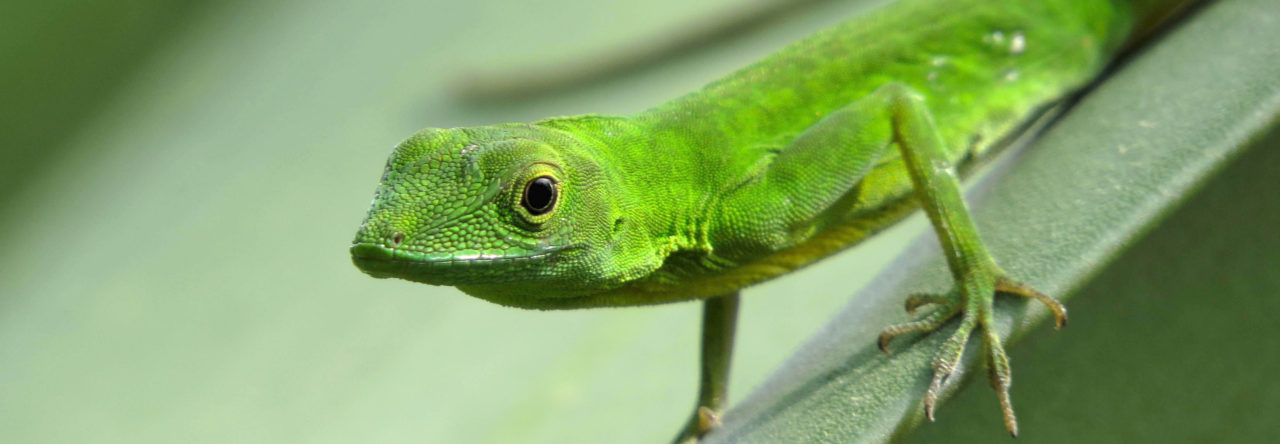I come to you, anologists of the world, with a request for your photos of anole dewlaps. I’m planning a study of dewlap size evolution across the Anolis phylogeny, but there’s not much data available for many of the less common species. I know many anole-hunters take pictures of their quarry with dewlaps extended after catching them, so I thought I’d try to extract data (e.g. dewlap length and area) from a collection of photos. If you have photos you might be able to share, please read on, and feel free to contact me if you have questions.
Requirements:
-The photo should show a live, adult male caught in the wild. Its dewlap should be fully extended – ideally either of its own volition or with tweezers, but fingers are ok as long as at least 90% of the dewlap area is visible.
-The anole’s entire head should be in the photo (so I can scale dewlap size relative to head size). If there’s a ruler or object of known length in the photo that’s even better.
-The photo should be close to a side-view profile (give or take no more than about 10 degrees angle in any direction).
-At a minimum, identify the species and the approximate location (country or island). Please do include any extra information you can share (e.g. date, latitude/longitude/altitude, snout-vent length of anole, weather…), but I know this may not be available for all the photos.
 Clearly I’m new to this – any photo better than this one should be useable.
Clearly I’m new to this – any photo better than this one should be useable.
Check out the comments section of this post for some better examples.
If you have one or more suitable photos you can contribute, please send them to me as an attachment to an e-mail. If you have large files or many photos (more than ~5MB) that may not make it through e-mail servers, drop me a line and I’ll send you a link to a Dropbox folder instead. If you are willing to give permission to use the photo (with full credit, of course) in potential blog posts, web pages (e.g. Encyclopedia of Life entries), or publications, please say so in the e-mail; otherwise I will only use the photos to extract basic measurements.
- A Hierarchy of Niches in Puerto Rican Anoles - July 27, 2022
- Puerto Rican Anole Diet Samples Available to a Good Home - October 19, 2018
- Anoles Are Habitat Specialists at the Individual Level Too - January 16, 2017


Rich Glor
My lab has hundreds, if not thousands, of images that could potentially be used for your project. Although we would be interested in sharing these images, we have a number of questions (1) Can you explain more about your intended uses for the data (How, exactly, will you be measuring size? What quality control measures will you use to ensure that the data extracted from contributed images is useful? What specific questions will be addressed with the data?), (2) How you will track/credit/acknowledge individual contributors?, (3) When and how will you make your measurements and analyses public?
Travis Ingram
Hi Rich,
I’ll send you an e-mail to discuss particulars, but your questions will probably be of interest to others, so here goes:
(1) The main measure will be dewlap area, measured by tracing the outline in Photoshop. I’ll probably take a couple of linear measurements too (e.g. maximum front-to-back extent of the dewlap, and maximum projection from the body), as well as non-dewlap measurements (head and eye size) to use for estimating relative dewlap size. I’m not completely sure yet what quality-control will be needed (aside from whether photos meet the criteria above). Some that come to mind will be using the species that are available from multiple sources to quantify the measurement error due to different observers or methodologies (e.g. voluntary vs mechanical dewlap extension), and using the more complete datasets to look at dewlap area/head length/SVL relationships to make sure the signal is coming from dewlaps (rather than variation in head length).
I’m interested in using the data to test two somewhat distinct hypotheses about the role of dewlap evolution in speciation. First, I plan to infer the relative contribution of gradual evolution and rapid ‘speciational’ evolution (see this post) to the total diversification of different traits (including morphology, habitat and dewlap size). Second, I’m interested in using the ‘diversitree’ methods to test whether larger dewlaps are associated with higher rates of speciation (which could be because they indicate stronger sexual selection, or a larger canvas on which diversification in dewlap color/pattern can occur). In short, hypothesis 1 is that dewlap size tends to change during speciation, while hypotheses 2 is that dewlap size changes, then speciation rate increases.
(2) I’ll keep track of who contributed each photo in the dataset, and in any papers I’ll acknowledge all contributors (I may acknowledge the Anole Annals readership as a whole if the list becomes too long), and specifically credit individuals who contributed (with permissions) any photos that get published as figures/journal covers/etc.
(3) I’ll put the extracted data into Dryad whenever I publish on it, so it will be available for anyone to reuse. I have no personal interest in hoarding the photos, so I’m happy to make them available as long as the contributors have given permission (It’s been suggested to me that they could be used on the Encyclopedia of Life, and I’m happy to take any other suggestions for where photos can be made useful). Plus, of course, you can expect some thrilling posts here on Anole Annals!
Rich Glor
Thanks for your responses to my previous post. One important complication to keep in mind as you develop your analyses is that dewlap size often shows dramatic variation within species. I realize this is true of all traits, but seems particularly true of dewlaps. This is particularly evident in some of our captive born animals.